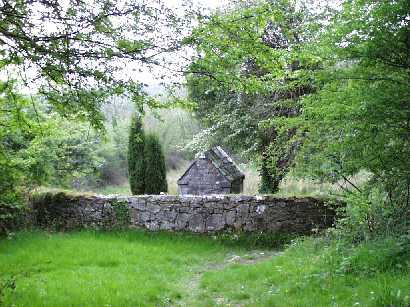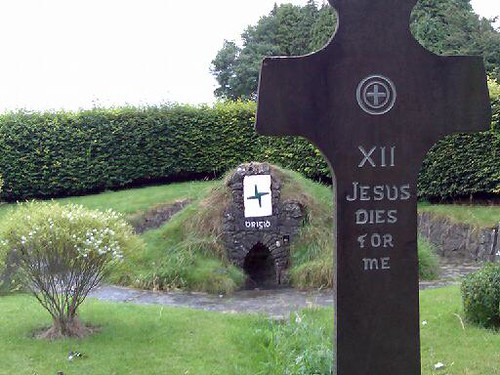 Seethe bottom of this post for a list of Brigid's wells, from Conrad Bladey's site, and an essay on Irish holy wells by Mary Ellen Sweeney. For her list of Irish holy wells, please follow the link (below) to her article in BellaOnline: the Voice of Women.
Seethe bottom of this post for a list of Brigid's wells, from Conrad Bladey's site, and an essay on Irish holy wells by Mary Ellen Sweeney. For her list of Irish holy wells, please follow the link (below) to her article in BellaOnline: the Voice of Women.
St. Brigid's Well is located across the river from the ruins of Castle- magner castle. It is a druidic well adopted into Christian ritual. It was originally the well of Brede (the druidic goddess of agriculture) and later, in the Christian era, became the well of St. Brigid of Kildare. When the parish of Castlemagner became a Protestant parish in 1591, Roman Catholic mass was celebrated there on Sundays, and it hence became known as a Sunday's well. This practice was stopped in 1658 when Captain Roger Bretridge became landlord of this area as a result of the Cromwellian confiscations. However, the practice resumed per- iodically after Catholic Emancipation in 1829. Between 1658 and 1704, rounds of the well was one of the few Catholic rituals allowed in the par- ish. The well was refurbished and covered over in 1771 by Mr. Eoin Egan of Subulter, a cripple who was miraculously cured at the well. It is a beehive shaped covering with an opening to the well at the eastern side. On the left of the opening is the best preserved effigy in the world of Shíla-Ní-Gig, a druidic symbol of the supreme goddess of fertility. This was brought by Mr. Egan from the ruins of an 8th century church in Subulter. On the right of the opening is an effigy of the Archangel Michael. This was the centre keystone on the arch of the main entrance to Magner's castle and dates from approximately 1200...
Beehive with Sile na Gig.............. Site of St Brigid's Well From 800 until 1461, the Shíla-Ní-Gig at Castlemagner Holy Well was attached to the inside of the wall of Subulter church, which explains its well-preserved state. The Holy Well in Castlemagner was the scene for a series of lectures, 18th October 1998, on the place of the Holy Well in Irish Mythology and in early Christianity. Until the dedication of the new church and parish of Castlemagner to Saint Mary in 1867, the parish and the Holy Well were anciently dedicated to St Brigid in the Catholic and Church of Ireland persuasions... ********************************************************************
Dave Walsh has a wonderful slide show of photos of Brigid's Well at Liscannor. DO go and have a look.  He says: Wall and crosses at St. Brigid's Well, Liscannor, Co. Clare On the Liscannor - Doolin road, near the Cliffs of Moher, this ostens- ibly holy well is full of wonderful, decaying votive offerings. St. Brigid never actually existed in Christian times - in mythology she was the "exalted one" - daughter of the Dagda and therefore one of the Tua- tha De Danann.....The "cave" at St. Brigit's Well is full of strange ob- jects. Decaying statues, rotting dolls, faded masscards, abandoned prosthetic limbs, rosary beads, toys, polaroid photographs.... Other photographers images of Liscannor: **********************************   ******************************************************* Killare, Co. Westmeath John Smyth has a lovely series of photos of this well. He says: > Westmeath > St Brigid's Well, Killare St. Brigid's Well, at Killare, Co. Westmeath. It's near the legendary Hill of Uisneach, and the easiest way to visit the well is to park at the nearby Uisneach Inn and walk back to it. ***************************************************** Faughart Upper Church graveyard, Dundalk: St. Brigid's WellIn some traditions, Faughart is St. Brigid's birthplace: "St Brigid was born in a quiet village named "Faughart" set upon a hill over looking Dundalk Bay. She was born about the year 454 A.D." near the east coast on the border between Northern Ireland and the Republic. ********************************
********************************
|









.jpg)





No comments:
Post a Comment